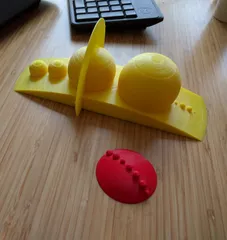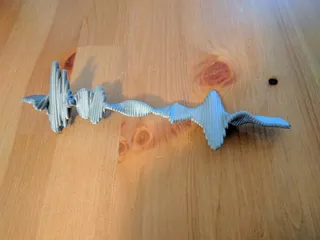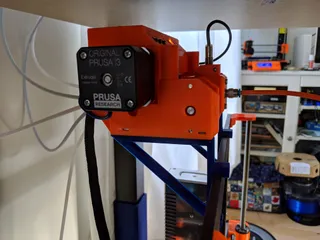Roche potential
Description
PDFThis describes the gravitational and centrifugal potential around an accreting neutron star. Called PSR J1023+0038, this system was a radio millisecond pulsar orbited by a vaguely Sun-like star. In 2013, something changed and the Sun-like star started dumping material on the pulsar. This model illustrates how: the larger object is the potential around the two objects. Gravity produces the wells around each object, while centrifugal force causes anything too far out to be flung away. The five Lagrange points are the peaks and saddle points of this model. The companion is less massive than the pulsar, so it sits in the smaller of the two wells, but the wells are so small - this whole model would fit inside our Sun - that the companion nearly fills its well. In fact, when accretion started, the companion started overflowing its well and material started falling towards the pulsar. The smaller piece of this model represents the companion filling its well just enough for matter to reach the L1 point (between the stars) and fall in to the pulsar, where it gets so hot it blazes in X-rays.
Print instructions
Category: Physics & Astronomy Print Settings
Printer: Kossel Mini
Rafts: No
Supports: No
Resolution: 0,2 mm layer height
Infill: 10%
Notes:
This model is a very easy print; the main challenge I had was that it liked to pull up from the bed.
I recommend printing the potential in black (space!) and the companion in orange or yellow (it's actually pretty close in colour to our Sun).
You could scale the whole thing vertically as much or as little as you liked, but these proportions seem aesthetically pleasing.
How I Designed This
The Roche geometry is given by a simple formula (whose derivative gives the combination of gravity and centrifugal force). The only real input it needs is the ratio of the masses of the objects, which in this case is 7.2. Supplying other ratios would give a different-shaped potential. I feed this value into an ipython notebook (included), shift and scale vertically so that L1 is at zero and L4/L5 area at 1, and write out a text matrix giving the values everywhere above a minimum. I also write an OpenSCAD file that creates the module and defines certain key quantities. OpenSCAD can read this in and make an object; the companion is made by Boolean operations within OpenSCAD.
The files are kind of huge just because I like smoothness.
Tags
Model origin
The author marked this model as their own original creation. Imported from Thingiverse.




